E-COMMERCE MARKETING
The AI-powered marketing platform built for e-commerce
Break through the noise, reach your audience, and drive revenue with the #1 email marketing and automations platform*.
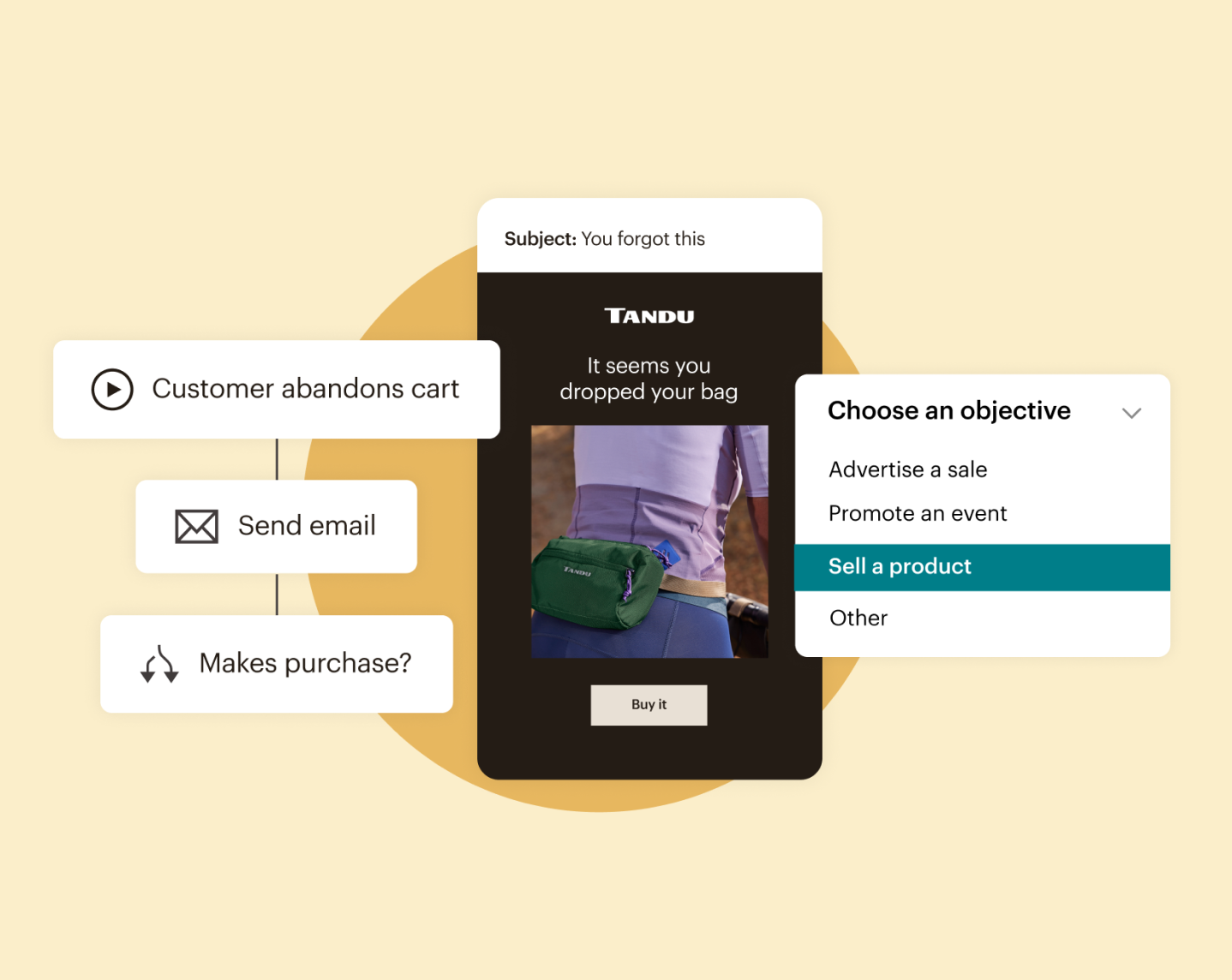
Engage your visitors and convert more customers with AI-driven insights
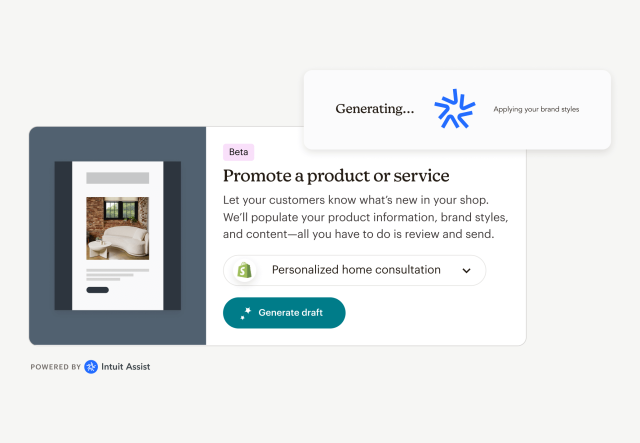
Let Intuit Assist help you personalize your marketing at scale*
Use the power of generative AI to automate manual marketing tasks—like writing the first draft of your next promotion—to drive customer engagement and conversions.
Easily automate your e-commerce marketing
Use automation to send consistently on-brand transactional emails and campaigns that engage customers and generate revenue. Scale quickly with a variety of pre-built flows, each customizable to your unique needs.
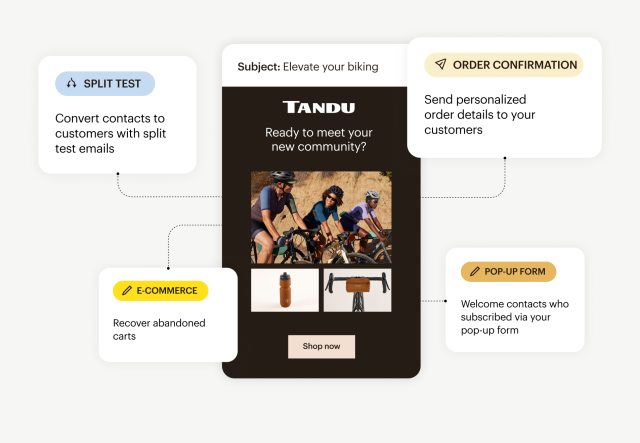
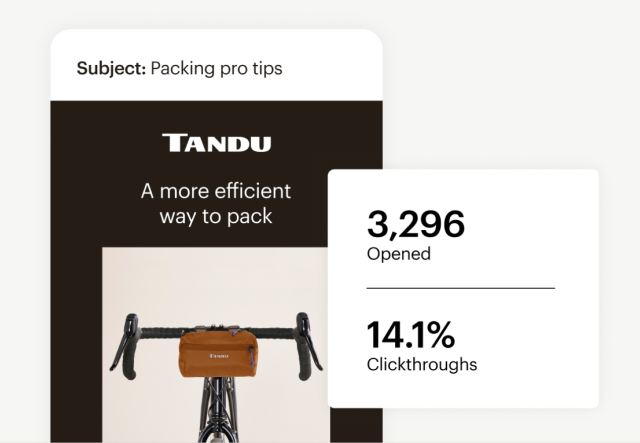
Drive sales by boosting open and clickthrough rates
Optimize your marketing with advanced reporting and analytics. Mailchimp collects and analyzes data from customer clicks, purchases, and other interactions to find useful insights.
Manage your entire audience from one place
Gain a holistic view of your audience and send targeted campaigns that drive engagement and sales. Mailchimp can identify key segments to help make your messaging even more effective.
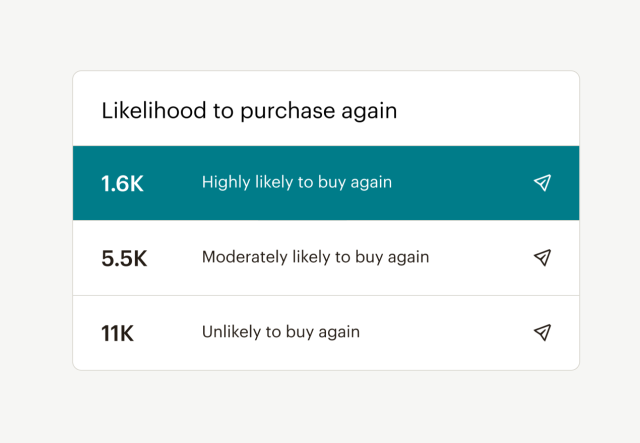
Mailchimp integrates with top e-commerce platforms
Mailchimp customers saw an average lift of 21% to their click-rates within one week of connecting their store*.
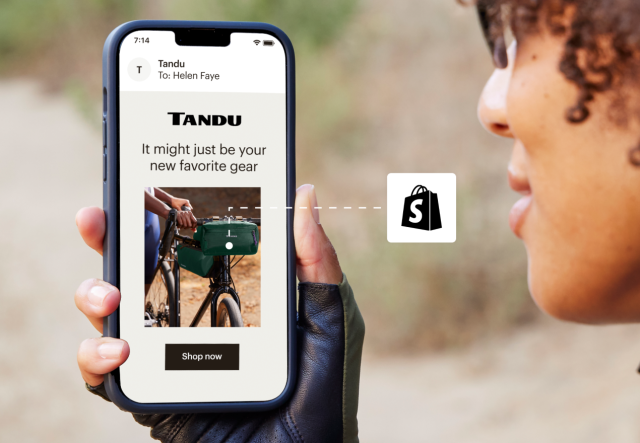
Mailchimp and Shopify: The perfect match.
With powerful automation and segmentation tools, Mailchimp empowers Shopify users. Mailchimp customers who connect their Shopify stores generate an average revenue of over $2100 per campaign*.

“We're in the business of making drinks, not necessarily building lists of customers.”
Joe Slater, Six Barrel Soda Co-founder & Managing Director, NZ
97% new contacts from Shopify integration (Jun–Jul 2022)
$1,426 avg. revenue ($NZ) per email campaign (Dec 2021–Apr 2022)
Get started easily with a personalized product tour
Schedule a call with an onboarding specialist at any time during your first 90 days to help you get started with confidence—it’s already included with Standard and Premium plans.*
Premium
Scale fast with dedicated onboarding, unlimited contacts, and priority support; built for teams.
Talk to Sales You've selected more contacts than this plan allows
Starts at
Starts at $2450 per month for {contacts} contacts
- Phone & Priority Support
- Custom-coded and Pre-built Email Templates
- Multivariate and A/B Testing
- Enhanced Automated Customer Journeys
- Dedicated Personalized Onboarding
- Predictive Segmentation
- Campaign Manager
Standard
Sell even more with personalization, optimization tools, and enhanced automations.
Contact limit exceeded You've selected more contacts than this plan allows
Starts at
Starts at $130 per month for {contacts} contacts
- 24/7 Email & Chat Support
- Custom-coded and Pre-built Email Templates
- Multivariate & A/B Testing
- Enhanced Automated Customer Journeys
- Personalized Onboarding
- Predictive Segmentation
- Campaign Manager
Essentials
Send the right content at the right time with testing and scheduling features.
Contact limit exceeded You've selected more contacts than this plan allows
Starts at
Starts at $85 per month for {contacts} contacts
- 24/7 Email & Chat Support
- Pre-built Email Templates
- A/B Testing
- Basic Automated Customer Journeys
-
Personalized Onboarding
-
Predictive Segmentation
-
Campaign Manager

See terms
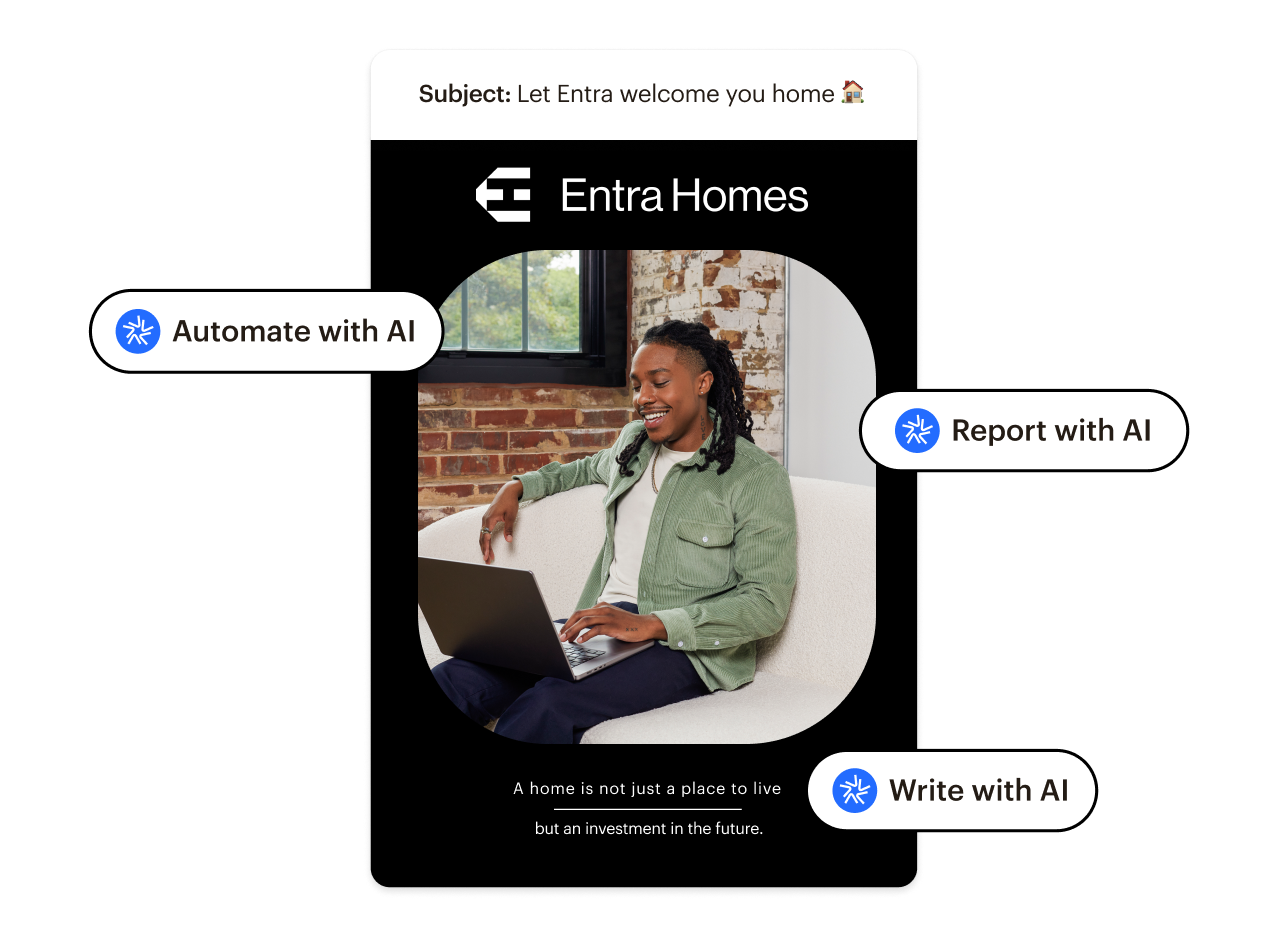

See terms

See Trial Terms. Overages apply if contact or email send limit is exceeded.

Free
Easily create email campaigns and learn more about your customers.
Contact limit exceeded You've selected more contacts than this plan allows
Starts at
Starts at $0 per month for {contacts} contacts
- Email support for first 30 days
- Pre-built Email Templates
-
A/B Testing
-
Basic Automated Customer Journeys
-
Onboarding
-
Predictive Segmentation
-
Campaign Manager
*Overages apply if contact or email send limit is exceeded. Free plan sending will be paused if contact or email send limit is exceeded.
Learn moreLearn more about e‑commerce marketing
FAQs
-
E-commerce marketing refers to the strategies and tactics used by businesses to promote their online store and increase sales of their products or services. This can involve various online marketing channels such as email marketing, social media marketing, search engine optimization, paid advertising, content marketing, and more. The goal of e-commerce marketing is to attract new customers, retain existing ones, and drive conversions through effective digital marketing techniques.
-
There are a number of e-commerce marketing strategies that businesses use to promote their online stores and increase sales. Some examples include:
- Email marketing: Sending promotional emails to subscribers with exclusive discounts, new product launches, and other offers.
- Social media marketing: Promoting products and services on social media platforms like Facebook, Instagram, and Twitter to reach a wider audience and increase brand awareness.
- Search engine optimization (SEO): Optimizing website content and structure to rank higher on search engine results pages (SERPs) and drive organic traffic.
- Paid advertising: Running ads on search engines, social media, and other websites to drive traffic and conversions.
- Content marketing: Creating and distributing valuable content such as blog posts, videos, infographics, and more to attract, educate, and engage potential customers.
- Influencer marketing: Collaborating with social media influencers and bloggers to create sponsored content and reach their audiences.
- Affiliate marketing: Partnering with influencers, bloggers, or businesses to promote products and services to their audiences in exchange for commissions or referral fees.
Overall, e-commerce marketing is all about finding the right mix of strategies to reach and convert the target audience into loyal customers.
-
Starting e-commerce marketing requires a well-structured plan and a clear understanding of your target market. Here are some steps to get started with e-commerce marketing:
- Define your target audience: Identify who your ideal customers are, their demographics, interests, behaviors, and pain points.
- Create an e-commerce website: Build a user-friendly and mobile-responsive website with high-quality product images, descriptions, reviews, and clear call-to-actions (CTAs).
- Optimize your website for search engines: Use relevant keywords, meta tags, titles, and descriptions to make it easy for search engines to find and rank your e-commerce site.
- Set up social media profiles: Create profiles on the social media platforms where your target audience is most active, and post engaging content and promotions.
- Launch email marketing campaigns: Build a subscriber list and send regular newsletters, promotions, and exclusive offers to keep your subscribers engaged.
- Leverage PPC advertising: Use paid search and social ads to drive traffic and conversions to your e-commerce website.
- Monitor and analyze your results: Use analytics tools to track your marketing efforts' performance and adjust your e-commerce marketing strategies based on the results.
Starting e-commerce marketing can be overwhelming, but following these steps will help get you on the right track towards attracting and retaining customers.
-
The perks of developing a good e-commerce marketing strategy and putting it to use are fairly straightforward. It means more users visiting your online sales portal and more coming back. But there are even more benefits that come with implementing an e-commerce marketing strategy, including:
- Attracting more customers
- Increasing conversions
- Improved e-commerce sales
- Improving visibility
- Establishing brand authority
Ultimately, it comes down to who your customer is. The best e-commerce marketing strategies will incorporate different marketing tactics to reach the right target audience.
-
There's a lot that goes into a good e-commerce marketing plan. Tools and techniques like search engine optimization, pay-per-click advertising, and content are just part of it, and any one of these by itself could be a full-time job. But for a start, we'll lay out the basics for an effective e-commerce marketing plan.
Conduct market research
The most important preliminary step is to understand the market you intend to serve. Markets on the internet can be difficult to define, and sometimes they don't even exist until you start your business. That can make market research challenging.
You need to discover your competition, measure demand, understand related products and services, and figure out how your brand will fit into the picture. Your business model may remain incomplete until this research is completed and vetted, since you want to gear your service to the market and not the other way around.
Define the target audience
Defining your target audience means discovering who wants what you offer, and who among that group most wants what you offer in the way you offer it. Consider two different burger restaurants: McDonald's and Burger King. On paper, they are the same. But if you put them on the same street side-by-side, some people will choose one and some will choose the other. On the internet, everything is "side-by-side." So, what is the difference between a user who wants to shop with you and a shopper who prefers the competition?
Set short- and long-term goals
Short-term goals might be compared to driving traffic underneath a "Grand Opening" banner. It's about kicking things off with a bang. Initially, you'll want traffic, conversions, and engagement. But these, in the short-term, are really just a proof of concept that your business has wheels and can sustain itself.
Long-term goals are about building a dedicated audience with brand loyalty that you can nurture, sustain, and grow. Long-term goals include community building, sustained exposure, and brand authority.
-
Unless you're duplicating another company's marketing strategy, then no two e-commerce marketing strategies are alike. As long as your unique value proposition is truly unique, your marketing efforts should be specially tailored to suit your needs and the needs of your audience.
The good news is that tens of millions of successful businesses have contributed to the data we rely on to deliver results. That means implementing a successful plan has been reduced to an exact science.
Identify and segment your audience
Little is more important than knowing who your audience is, but the importance of precision cannot be overstated. That is where audience segmentation comes in. With audience segmentation tools, you can create more personalized marketing campaigns that appeal to your customers’ unique needs.
Track performance
The data is out on buyers, sellers, what works, and what doesn't. However, markets are constantly shifting. That means you need accurate and persistent metrics that you can count on, metrics that let you know which way the numbers are going, and the data you need to figure out why.
The best marketing departments actively track performance across a range of categories and persistently update market models in order to stay one step ahead of the target audience's next buying move.
Personalize the customer experience
Finally, the ultimate in audience targeting is the ability to personalize your brand experience down to the individual consumer. For a successful email marketing campaign, this is absolutely necessary. Once again, failure to do this runs the risk of being marked as spam, even after multiple successful transactions. That's why we take personalization extremely seriously.
-
When you use Mailchimp for e-commerce marketing, you’ll discover more ways to achieve your marketing goals and grow your business. Our e-commerce tools help you find new audiences, promote your products, boost customer loyalty, and track your sales.
Find new customers
If you need to attract new customers, you’re in the right place. Mailchimp makes the most of your site traffic with pop-up forms, and helps you reach a new audience with online ads.
Promote your products
Mailchimp has lots of tools that help you sell more stuff. Use e-commerce data from your connected site to personalize your messages, so you recommend the right products to the right customers.
Abandoned cart
Abandoned cart messages remind customers to finish a purchase they started in your store. These messages can be sent as a single email or as a series of reminders. Try adding a discount code for extra incentive.
Personalized product recommendations
Use purchase history data to give your customers smart suggestions for their next purchase. Add personalized product recommendations to any email, including abandoned cart messages and order notifications. The more data you have, the better it works: We recommend it for stores that have at least 10 products and processed at least 500 orders in the last year.
Boost customer loyalty
As you connect with more people and your business grows, Mailchimp can help keep your customers coming back. Create segments and send purchase-based automations to reach your target audiences, and use data and testing to find out what’s working.
Customer journeys
Mailchimp’s Customer Journey feature provides a great way to build dynamic, automated marketing paths for your contacts. Create a journey map that gives your contacts a personalized experience with your brand. Use shopping activities as starting points, branching points, and segmentation options to share your products and your story with your audience.
Customer segments
Segments are custom audiences based on purchases, demographics, and other shared data. Create your own, or choose one of our pre-built segments to quickly target first-time buyers, top customers, or people who haven’t made a purchase lately.
Track your sales
As you integrate more tools into your marketing plan, we’ll keep track of your return on investment (ROI), so you can figure out what’s working. You probably don’t have time to dig through the data, so we do it for you in your reports.
Mailchimp’s e-commerce reports detail your store’s purchase activity and order history. See which items your customers buy, and how much revenue each campaign has created. Then, use this data to create even more specific segments and more effective marketing.
Millions of users trust us with their email marketing. You can too.
*Disclaimers:
- #1 email marketing platform: Based on December 2023 publicly available data on competitors' number of customers.
- Intuit Assist: Intuit Assist functionality (beta) is available to certain users with Premium, Standard and Legacy plans in select countries in English only. Access to Intuit Assist is available at no additional cost at this time. Pricing, terms, conditions, special features and service options are subject to change without notice. Availability of features and functionality varies by plan type. Features may be broadly available soon but represents no obligation and should not be relied on in making a purchasing decision. For details, please view Mailchimp’s various plans and pricing.
- 21% click rates: Based on Mailchimp customers who connected their stores with Mailchimp's e-commerce integrations as of October 2022.
- Average revenue of $2100: Based on Mailchimp users with a paid plan and Shopify connected stores, for campaigns that generated revenue between January and November 2022.
- Personalized onboarding: Onboarding services differ per plan and are available for new or upgraded users with a Standard or Premium plan for the first 90 days after account creation or upgrade. Onboarding services are currently offered in English, Spanish and Portuguese for Premium plans, and in English for Standard plans.
- Availability of features and functionality varies by plan type. For details, view plans and pricing.





